

| search engine by freefind |
- Home Page
- Biographies
- Obituaries
- Marriages
- Queries
- Newspaper Clippings
- Photos
- Maps
- Local Contacts
- Online Resources
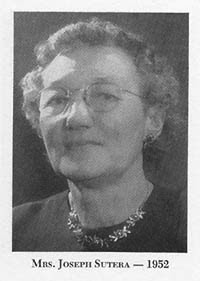
The Eminent Homemaker Award ~ 1952
Mrs. Joseph Sutera, of Tabor, South Dakota, was born November 14, 1893, only two miles from her present home northwest of Tabor and has spent all of her life in the same community. Her maiden name was Marie Vavruska. She attended country school through the sixth grade, and helped her parents on the home farm until her marriage to Mr. Sutera in 1915.
Source: South Dakota State University
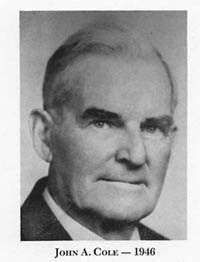
The Eminent Farmer Award ~ 1946
John A. Cole was born April 1, 1875, three miles south of the farm near Tyndall where he now lives. His parents homesteaded in 1869, coming to South Dakota from Missouri in a covered wagon.
One of his most vivid memories is the walk of a mile and a half from school with his brother through the 1888 blizzard, walking against the storm. Mr. Cole taught school in 1892, attended Yankton college academy the next year, taught school again and then went to Fremont, Nebraska, Normal. The following year he homesteaded in Charles Mix County.
After proving up his place in 1901, he rented it and moved to his father’s homestead. In 1909 he married Mary Benesh, a cousin of former President Benes of Czechoslovakia. In 1912 they purchased the 320-acre farm where they now live; the second family to own the place.
They are the parents of seven boys.
Mr. Cole was a Bon Homme County delegate to the 1933 AAA meeting in Washington and served ten years as a committeeman. He has been county vice president of the Farmers’ Union, a supervisor of the Scotland Soil conservation district ad a director of the Farmers’ Mutual insurance association.
Mr. Cole raised purebred Hampshire hogs and good red polled cattle. He used purebred boars and bulls. He raised between 50 and 240 hogs every year.
Part of the original place was a tree claim. The Coles have also planted a shelter belt. Mr. Cole holds an annual school picnic for his old pupils. In 1942 on the fiftieth anniversary 18 of the original group were present. All 27 of the group were living at that time. The group meets at the same building four miles north of Tyndall. Mr. Cole believes he holds a record with his pupils.
In 1945 he moved to Tyndall, but he keeps busy helping to manage the home farm and two farms belonging to his sons. He retains an interest in many farm organizations and seldom misses a meeting of any of them.
Source: South Dakota State University
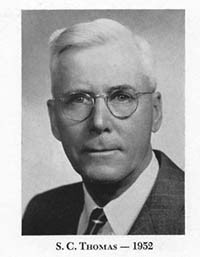
The Eminent Farmer Award ~ 1952
Mr. Sampson C. Thomas was born October 30, 1891, on the old Thomas homestead just two miles west of his present home.
Young Thomas finished eighth grade in the Equal Rights rural school and attended Springfield State Normal three years.
After working with his father on the farm until he was twenty-one years old, he married Ladie E. Boyd in 1913. They reared three boys and two girls.
In March 1914, they moved to their present home, renting from Sampson’s father for three years and then buying the 120 acres about three miles west of Springfield, South Dakota.
The original 120 acres now have been expanded to 600 acres and are farmed in partnership with a son.
Mr. Thomas has been raising purebred Poland China hogs for thirty years. Other livestock on the farm include commercial cows and heifers, with a purebred Polled Hereford bull.
He grows alfalfa and sweet clover in rotation with other crops for feed and as a means of maintaining his soil’s productivity.
Mr. Thomas was the first county chairman of the Wheat Allotment and Corn-Hog programs in 1935. He held this job with the AAA and later the Production and Marketing administration for nine years. He has been treasurer of the Niles school district (No. 39) for thirty-three years. He was president of the Bon Homme County Farm Bureau for ten years and on the state board of directors for three years. He has been chairman of the county Crop Improvement association for five years, and was a member of the state Livestock committee. In 1946, he helped organize the local unit of the Rural Electrification association; he was a 4-H club leader for six years. For twenty years he has been an active member of the Athenian Debating society in Springfield. He also has maintained active membership in the state Poland China association.
For twenty years he was superintendent of the Sunday school in Springfield. He still teaches his Sunday School class at the Springfield Congregational Church and has served as both deacon and trustee.
In 1935, he was presented with the state Farm Bureau Distinguished Service Award; and in 1946, he received the Skelly Farm Award for Superior Achievement in Agriculture.
Source: South Dakota State University
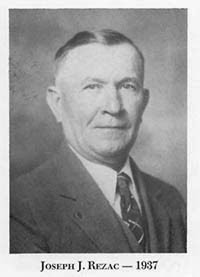
The Eminent Farmer Award ~ 1937
Joseph Rezac, Tabor, South Dakota, was born December 2, 1878, on the same farm where he built his home and well-known farming and livestock operations. His father, Joseph Rezac, Sr., came from Bohemia and homesteaded, in 1869, in what is now Yankton County.
Joe left school at an early age to help his father on the farm. When he was 21, he married Theresa Novotny, and assumed management of the farm. To Mr. and Mrs. Rezac were born seven children—five boys and two girls.
Mr. Rezac has specialized in Hereford cattle. The blood of the herd is now principally of the Domino strain.
The Rezac and Sons Herefords have won many prizes, trophies and ribbons from the Iowa, South Dakota and Minnesota State Fairs, the Chicago International, Denver National, Western, Kansas City Royal, and Omaha Ak-Sar-Ben Livestock shows.
His greatest herd sire was Repeater 191st whom Mr. Rezac purchased at the close of the 1919 show season in which Repeater defeated all competition in every show and fair of note in the United States.
The Rezacs fattened 200 head of steers and heifers each year for the beef market. The topped the Sioux City and Chicago markets with at least part of their cattle every year they fed. Since 1912, the Rezacs raised grade Hampshire hogs to follow the cattle in the feed lots.
The original homestead of 160 acres in 1869 grew to 600 acres, and the Rezacs leased an additional 2,000 acres.
Mr. Rezac was a firm believer in the policies of the Agricultural Adjustment Administration. He was a member of the Yankton County Farm Bureau Federation, and served from 1919 to 1931 as a member of the board of county commissioners.
He was a life-long member of the Tabor Catholic Church, and was baptized and married in the same church, and is a firm supporter of home and community life.
Mr. Rezac believes that any farmer, whether he plans to raise beef or dairy cattle, hogs or sheep, should be satisfied with only the finest livestock available. Livestock farming, he says, is far superior to grain farming in his part of the state.
Source: South Dakota State University
Antoine Robeart's saloon was the rendezvous not alone of the merry-makers but of the statesmen with important matters of state to discuss; of politicians who had plots to lay and plans to make; it was a meeting ground for all classes, and reveling in a mild way was nightly witnessed within its walls where songs were sung and speeches were made and stories related, and the news was discussed. It was quite a center of interest at all times and especially during the Legislature of March, 1862, although as a rule the law makers of Dakota from first to last, as they appeared at Yankton, were not immoderate drinking men, and we cannot recall an instance of the intoxication of a member of either body during the session of any Legislature that met at Yankton covering a period of twenty-one years. It is more than probable that Antoine's attractive hall would have been less visited had there been other places, as there were later, for legislators and lobbyists to get together. In connection with Robeart's place an incident occurred during the pendency of the capitol fight that deserves mention. A large party of gentlemen had retired to the rear room of the saloon to discuss the situation. Suddenly the window, opening upon Third Street, flew up and Speaker Pinney popped out as though there had been a force behind him, and started down the street at a gait that was faster than a walk and slower than a run. Behind him pursued another member of the Legislature, and behind this member was Robeart swinging his arms furiously and behaving like a person very highly enraged. Pinney walked briskly across Broadway, and as he went along drew a pistol from a pocket. When he reached the east side of the street he stopped short and allowed the others to overtake him. Observing a remarkable change in the manner of the two pursuers when they reached Pinney's side, indicating that their belligerent ardor had moderated, it was evident that they had seen the weapon in Pinney's hand, and it was fortunate for both parties that they did not crowd him, for his subsequent career in Montana proved him a man of nerve who would use his gun if occasion called for it. The conversation that followed was not intelligible to parties who had witnessed the affair but the gestures made by the pursuers were not belligerent, nor was their posture one that meditated assault.
Pinney shot and killed a former lieutenant governor of Wisconsin, named Beall, of Helena, Montana, a few years later, an account of which appears elsewhere; which would justify the assumption that he had decided to use his weapon on this occasion and would have done so had there been sufficient provocation._______________________________
These pioneer legislators and the officers of each body represented nearly every state in the Union.
John Shober, of Bon Homme, president of the Council, was born in the year 1833, in Loudon County, Virginia (his ancestors were of Switzerland), removed to Ohio, then to Illinois, next to Minnesota, and from that state to Dakota (in 1859). By profession a lawyer. Age twenty-nine. He was unmarried. A democrat. Resides now at Helena, Montana.
W. W. Warford, of Bon Homme, fireman, was born in Pennsylvania in 1836. Removed to Minnesota; thence to Dakota in 1859. He was a farmer. Aged twenty-six and single. Democrat. Died at Bon Homme.
George M. Pinney, of Bon Homme, speaker, was born in Pennsylvania in 1833. Removed to Wisconsin. Studied law at Madison and was admitted to the bar. Removed to Dakota in 1861. Was married. Aged twenty-nine. Republican. Removed to Montana; thence to California. Died at San Francisco.
Reuben Wallace, of Bon Homme, was born in Vermont in 1812. He was the oldest member of either house, and one of the oldest men in Dakota. He emigrated to Minnesota; thence to Dakota in 1858. Was a farmer; not married, and a democrat.
Daniel Gifford, of Bon Homme, enrolling clerk, born in New York in 1837. English ancestry. Farmer. Removed to Dakota in 1858. Age twenty-five. Single, and a democrat.
Byron M. Smith, of Bon Homme, engrossing clerk, born in New York in 1834. Scotch-German ancestry. Farmer and geologist. Removed to Sioux Falls, Dakota in 1857. Age twenty-eight. Single. Died in Minnesota. Rev. M. D. Metcalf, of Bon Homme, chaplain, born in New York in 1825. Clergyman and farmer. Removed to Dakota in 1860. Age thirty-seven. Married. Republican.
Source: History of Dakota Territory, Volume I by George Kingsbury ~ 1915
The Legislature.
A Complete List of the Members of Both Houses, Their Life and Public Services
Taylor O. Bogert, of Scotland, Bon Homme county, Third District, was born in Jefferson county, N. Y. in 1851. He came to Dakota six years ago from his native state. He has held no office previously, but is an active member of the Dakota state senate. He is at present engaged in the banking business and is also an attorney.
(Note: I only transcribed the section of the article pertaining to Bon Homme county.)
Source: Bismarck (North Dakota) Weekly Tribune ~ January 14, 1887
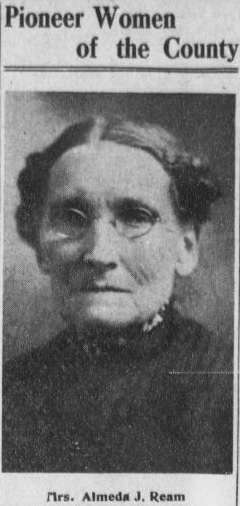
Mrs. Almeda J. Ream was born October 27, 1834 near Nauvoo, Illinois. She came to Omadi, Dakota county, March 1, 1856, with her first husband, Abraham Hirsch, and two children, Henrietta and Laura. The following day, March 2nd, little Laura died, and there was no lumber to be had in the town to make a coffin. One man took enough boards from his cabin floor for the purpose. Mrs. Jesse Wigle (long since deceased) the only other white woman in the county, came and aided in every way she could. Following this bereavement it was eight weeks before she saw a white woman again. Three other children were born to them - Lue A Hirsch of Pender; Della, who died in 1864; and Frank M Hirsch of Sioux City. Abraham Hirsch died at Bon Homme, SD. The first meeting and organization of the county and election of officers was held in her home.
In 1867 she was married to Henry Ream. To this union was born five children, three of which are living: Dr. Nina R Smith of Homer; Leon L Ream of Pender; and Dr W. R. Ream of Walthill.
Mrs. Ream is now THE pioneer woman of Dakota county.
Source: Dakota County (Dakota City, Nebraska) Herald ~ August 5, 1910
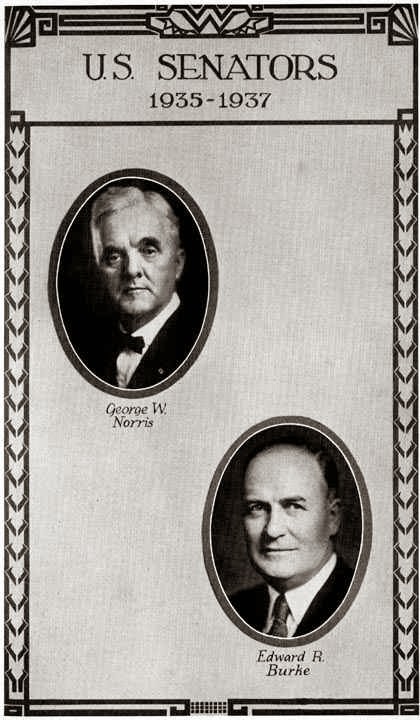
Edward Raymond Burke (Democrat). Born at Running Water, South Dakota, November 28, 1880. Educated in public schools; received a A. B. degree from Beloit College, 1906 and LL.B. degree from Harvard Law School, 1911. Is a lawyer. Married Henrietta Flinn; two children. Served as second lieutenant in the air service in the World War. Served as representative in seventy-third congress; elected to United States Senate for term beginning January 3, 1935. Address: Omaha.
Source: Nebraska Blue Book ~ 1936
Rt. Rev. Monsignor Emanuel Anton Bouska was born in Borovany, Tabor Region in Bohemia, on November 18, 1865. He began and finished his secondary school studies in Tabor. Then he studied law at the Vienna University and at the same time performed his military duty as a one years volunteer. He entered the seminary in Styrsky Hradec and, together with Rev. J. S. Broz and Vranek, Pastor of St. Wenceslaus Parish in Omaha, left for Chur, Switzerland, where on July 14, 1889 he was ordained a Priest. After that he came to America and became Pastor of the Czech parish at St. Ludmila in Crete, Nebraska, where he built a church a rectory. After that he was transferred to Wahoo, Nebraska and served Plattsmouth as a mission. Then he came to Kimball, SD in the spring of 1893, and in the fall of the same year was appointed Pastor at Tabor, SD. He is still occupied here.
The following occurred during the activity of Msgr. Bouska: 1879 baptisms, 278 marriages, 533 burials, 779 children's first communions, and 1027 confirmations.
Source: History of the Czechs in the State of South Dakota by Joseph A. Dvorak ~ 1920
(1980 English Translation by The Czech Heritage Preservation Society)
Charles Cooley, a well known attorney of Siloam Springs, who for forty-nine years has followed his profession, is also conducting a large insurance business, and success has rewarded his efforts in both branches of activity. He has passed the Psalmist's allotted span of threescore years and ten, for his birth occurred at Havre de Grace, Maryland on the 24th of November, 1848. He is a representative of an old southern family, his father, Daniel M. Cooley, having been born upon property in Maryland which has been in possession of the family since 1636. He became a prominent planter of that state, and his political allegiance was given to the democratic party, while in religious faith he was an Episcopalian. He wedded Miss Harriet Wiles, and they became the parents of nine sons, four of whom are living: Daniel M., who has no fixed place of residence being fond of travel and change of scene; Charles, of this review; Lawson, a resident of Aberdeen, Maryland, where he is serving as clerk of the court; and G.W. who makes his home at Mitchell, South Dakota, and is in the railway mail service. The paternal grandfather, James Cooley, was a large landholder and also owned many slaves.
In the acquirement of an education Charles Cooley, attended the district schools of Maryland, Newark Academy of Newark, Delaware, and the Maryland Agricultural College, where he remained until 1871. He took up the study of law under H.W. Archer of Bel Air, Maryland, a brother of Colonel James Archer of the Confederate army. In December 1872, he was admitted to the bar, and going to Yankton, South Dakota he entered upon the work of his profession, subsequently removing to Bon Homme, that territory, where he resided for three years. His next removal took him to Niobrara, Knox county, Nebraska, where he engaged in practice for nearly eight years, serving during four years of that period as county judge. He then went to Madelia, Minnesota, where for sixteen years he continued to follow his profession, and in January of 1899, he arrived in Siloam Springs, where he has since made his home. His clientage has constantly increased, and his business is now of a most important character. His knowledge of the principles of jurisprudence is comprehensive, and he has ever conformed his practice to the highest ethics of the profession. He purchased an insurance agency soon after locating here and has also built up a good business in that connection.
On the 18th of March, 1874, Mr. Cooley was united in marriage to Miss Jennie Goddard, a native of Monroe, Wisconsin, and a daughter of Alfred Goddard, who removed to that state in 1847, later going to Bon Homme, South Dakota where he died. Mr. and Mrs. Cooley have become the parents of four children: May, the eldest, married Frank Holmes, who is connected with transportation interests and resides at Spokane, Washington; Charles R., makes his home at Joplin, Missouri, and for the past twenty years has been connected with the post office at that place; Julia, married F.A. Davey of San Bernardino, California. During the World War he served as a lieutenant in the navy and also as assistant paymaster. Previous to the war, he had been connected with that branch of the service for fourteen years, but has now received his discharge. He is at present acting as secretary and treasurer of the California Automobile Company; Madge is the wife of Leon L. Brown, a railway mail clerk, and they reside in Siloam Springs.
The family are members of the Episcopal church, and fraternally, Mr. Cooley is connected with the Independent Order of Odd Fellows, in which he has passed through all of the chairs. He is a democrat in his political views, and while residing in Dakota territory, he filled the office of sheriff, being there at the time General Custer was killed. He has attained high standing in his profession, and his course has been characterized by integrity and honor in every relation, commanding for him the respect and goodwill of those with whom he has been associated.
Source: Centennial History of Arkansas, Volume 3 ~ 1922
Wicks, Walter James, born October 5, 1858, in New York city, son of Walter W. Wicks, and Ellen Kennedy, his wife. Married April 20, 1887, at Parker, South Dakota, Emeline S. Clisby, b. September 2, 1859, at Macomb, Illinois, daughter of Lorenzo Clisby, and Sarah E. Sparrell, his wife. Five children "Lorenzo Clisby, b. February 4, 1888; Ellen May, b. May 1, 1891; George Cornell, b. May 2, 1895, Albert Henry, and Warner Clisby, twins, b. April 23, 1898. Mr. Wicks was educated in the public schools of Fort Edward, N. Y., and at St. Stephen's College, where he received the degree of B. A, After his graduation, attended the General Theological Seminary in New York city, and Faribault Divinity School, Minnesota, where he received the degree of B. D. Is a member of the Protestant Episcopal church; a Republican in politics, a clergyman by profession, and is now superintendent of the United States Indian school, at Springfield, South Dakota.
Source: The Fort Edward (New York) Book by Robert O. Bascom ~ 1903
Wicks, Hon. Frederick D., of Scotland, county judge of Bon Homme county, South Dakota, born July 31st, 1866, at Fort Edward, N. Y., son of Walter W. Wicks, and Ellen Kennedy, his wife. Married November 12th, 1895, at Springfield, South Dakota, Mary L. Wood, b. February 24th, 1874, at Springfield, Dakota territory, daughter of Lester Wood and Emma Barron, his wife. Three children " Emma R., b. September 4th, 1897; Walter W., b. August 22d, 1899; Ellen M., b. June 18th, 1901. Judge Wicks was educated in the public schools of Fort Edward, and at Fort Edward Collegiate Institute, and his early life was passed here. After completing his course at the Institute he began the study of law in the office of Robert 0. Bascom, at this place. In August, 1890, went to South Dakota on account of his health, and was admitted to the bar in that state in December, 1890; was elected county judge of Bon Homme county in 1892, and is now serving his fourth term in that office. Belongs to Scotland Lodge, F. " A. M., Scotland Chapter, R. A. M., of Scotland, the Oriental consistory of Yankton, S. D., and El Riad Temple of Shriners at Sioux Falls; is a member of the Episcopal church; a Republican in politics, and is now in the enjoyment of a lucrative practice in his profession.
Source: The Fort Edward (New York) Book by Robert O. Bascom ~ 1903

Fred Christ Lang was born in Tyndall, South Dakota on October 31, 1919. His parents were Fred and Barbara Lang. Fred had four brothers and six sisters. Tyndall was Fred’s hometown. He went to Tyndall High School and graduated in May of 1939. Fred later was employed at the Hinky Dinky Store in Norfolk, Nebraska. He married Bernice Lang, and they had two children, Tom and Susan.
Fred was sent overseas during the Christmas season of 1943. Fred was then stationed in Italy. He served in the 338th Infantry Regiment of the 85th "Custer" Division on the Fifth army front. Fred fought bravely in the five day Battle of Altuzzo. Fred was a Tech. Sergeant.
Fred died on September 14, 1944, age 24, near the Appenine Mountains in Italy. After the platoon leaders of Sergeant Lang’s company died during the attack, he assumed command of both platoons. He lead the soldiers through an enemy mine field, directed artillery fire and assisted in the wounded. He also exposed himself to heavy fire in order to get more ammunition when it started to run low. While bravely fighting in the Battle of Altuzzo, Tech. Sergeant Fred Christ Lang was shot and killed.
Fred was buried at Plot D, Row 6, Grave 22 in a beautiful national cemetery in Florence, Italy. For gallantry in action with Lieutenant General Mark W. Clark’s Fifth Army, Fred was awarded the Purple Heart with 2 Oak Leaf Clusters and the Silver Star.
We will always remember the service and sacrifice of Tech. Sergeant Fred Christ Lang.
Source: South Dakota World War II Memorial
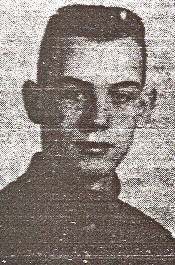
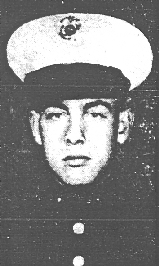
William (Bill) David Monfore was born May 21, 1943 in Yankton, South Dakota. His parents were Mr. and Mrs. R.W. Monfore. His siblings included a sister Maxine and three brothers: Gene, Bob and Jon. Bill graduated from Tripp High School in 1961 and for a time attended Southern State College in Springfield, South Dakota. In 1963, he married Sandra Oehlerts of Remsen, Iowa. Sandra and Bill lived in Sioux City, Iowa where he worked at Sioux City Dressed Beef before he entered the service.
Because he had an Iowa address, he entered the Marine Corps from Iowa. After his basic training, Bill was sent overseas in June 1966. He was stationed north of Da Nang, South Vietnam with the 3rd Battalion, 9th Martine Division. Bill returned home on leave in July to attend his father’s funeral. He returned to Vietnam in August 1966.
U.S. Marine Private First Class William David Monfore died of a gunshot wound in the Quang Nam Province, South Vietnam on November 3, 1966. His body was returned to the United States. After a funeral service at the United Church of Christ in Springfield, he was buried with military honors at the Springfield Cemetery.
Bill is currently survived by his wife, Sandra, Sergeant Bluff, IA and three brothers: Gene, Visalia, California; Jon, Kelseyville, California; and Robert, Tuscaloosa, Alabama.
A friend of Bill’s, Maynard Hieb, posted this remembrance at www.vvmf.org:
I was the left end, you the right end, our senior year in high school. We played basketball together. I chose the Navy, you chose the Marines. I got to raise a family, you did not. Your name is on our memorial in Tripp, SD. You will not be forgotten.
This entry was respectfully submitted by Andy White, 8th grade, Spearfish Middle School, Spearfish, South Dakota, on March 27, 2006. This information was provided by the Vietnam Veterans Memorial Fund website, the Springfield Times, November 11, 1966, and The Tripp Ledger, 11/17/66 issues. Additional information and profile approval by the Monfore family via Gene.
Source: South Dakota Vietnam War Memorial
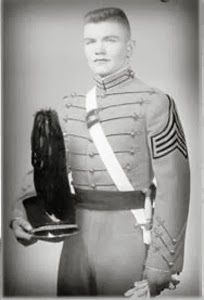
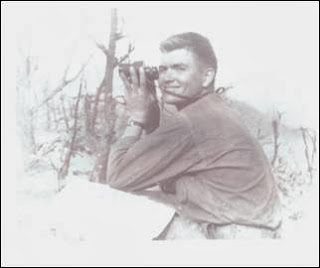
Peter Howland Monfore was born in Yankton, South Dakota, to Howland Swift and Gertrude Margaret (Kositzky) Monfore. Pete had three brothers, Robert, James, and Thomas, and one sister, Diana. Pete won academic honors and excelled in football and boxing while attending Washington High School in Sioux Falls, South Dakota. Upon graduation, he entered U.S. Navy Officers’ training, and continued boxing at intercollegiate level. In 1946, Pete received an appointment to the United States Military Academy in West Point, New York, where he became captain of the boxing team, eventually achieving the title of Eastern Intercollegiate light heavyweight champion in 1949 and 1950.
Peter Howland Monfore graduated from the United States Military Academy in 1950, and in August that same year was sent to Korea, and assigned platoon leader of Company E, 2nd Battalion, 23rd Infantry Regiment, 2nd Infantry Division, which had been engaged in heavy fighting while breaking out of the Pusan perimenter. He was seriously wounded in this action, and was evacuated to Japan. After treatment and recovery, 1Lt. Monfore returned to combat duty on 7 October 1950, and fought with his division all the way through North Korea to the Yalu River. When Chinese forces swarmed across the river, his heavy weapons company provided rear guard security for the 23rd Infantry Regiment, inflicting heavy casualties upon the attacking Chinese.
In August 1951, 1Lt. Monfore turned down an opportunity to be Aide-de-Camp to General Ridgeway. Instead, he chose to command an infantry company. He was made commander of Company L, 3rd Battalion, 23rd Infantry Regiment. 1Lt. Monfore fought in more intense combat, and received the French Croix de Guerre award for rescuing the encircled French Battalion. On 19 September 1951, his company was ordered to lead a night assault on Hill 851 during the battle of Heartbreak Ridge in North Korea. His company was successful in capturing Hill 851. Immediately, 1Lt. Monfore set about retrieving weapons and ammunition from dead enemy soldiers, showing his men how to use them as they established defensive positions.
1Lt. Peter Howland Monfore was killed in action while defending his position on Hill 851 on 19 September 1951. In a letter dated 21 October 1951, Colonel J. Adams, Commanding Officer of the 23rd Infantry, wrote these words to Peter’s father:
…Your boy was certainly as fine a soldier as West Point has produced. He lived up to every part of Duty, Honor, and Country. Among all the fine men we lost in this grinding battle, it is hard to say who could be the hardest to lose, but Pete had every attribute of greatness, and was potentially one of the Army’s bright young stars. For several hours we couldn’t believe he was really gone, and kept praying for his return. However, it was in vain; he was killed, and his body recovered from the top of Heartbreak, at the northern limit of our advance.
…Mr. Monfore, as a soldier, there is little in war to recommend itself to me. The only recompense is the sense of duty performed for our country, and the great comradeship and respect engendered for our fighting brothers. Your son, Sir, exemplified every fine attribute of a great soldier and a real man….
For his leadership, 1Lt. Monfore was awarded the Distinguished Service Cross, the Purple Heart with Oak Leaf Cluster, the Combat Infantryman’s Badge, the Korean Service Medal, the United Nations Service Medal, and the National Defense Service Medal. 1Lt. Peter Monfore is buried in Springfield, South Dakota. 1Lt. Monfore truly was a great U. S. Army leader.
Tyler John Reiman, 7th grade, Stanley County Middle School, Fort Pierre, South Dakota, May 5, 2004, respectfully submitted this entry. Information for this entry was provided by the 11 October 1951 Springfield Times, and retired Colonel Robert P. Monfore, brother to 1Lt. Monfore, who served three tours of duty in Korea. Additional information and a second photo provided by Diana Monfore Neil, sister, Yankton. Approval of profile by both Robert Monfore and Diana Neil.
Source: South Dakota Korean War Memorial
Source: Military Times Hall of Valor
On June 1, 1963, the inception of Hoch Funeral Home in Nebraska began when Robert and Marlene Hoch of Scotland, South Dakota, purchased the Huston Funeral Home in Bassett from Bob, Doris and Ruth Huston. In 1969, they partnered with the Wisda Funeral Home in downtown Ainsworth. On January 1, 1972, Robert and Marlene purchased the Ainsworth business from Gordon and Shirley Wisda. A new funeral home was built in 1973 on Highway 20, located on the east edge of Ainsworth.
Robert C. Hoch, a Tyndall, South Dakota native, was born on May 28, 1930 to Joseph and Anna (Zolnowski) Hoch in Yankton, South Dakota. He graduated from Tyndall High School in 1948. Bob served in the United States Army from 1948 to 1951. He attended college in Springfield, South Dakota before attending the University of Minnesota where he obtained a Bachelor's of Science Degree in Mortuary Science in 1956. He was united in marriage to Marlene H. Schneider, also of Tyndall, on August 22, 1957. Marlene was born to Frank and Helen (Herman) Schneider on November 20, 1933 at Wagner, South Dakota. She was also a Tyndall High School graduate. After high school, Marlene attended college at Sacred Heart Nursing School in Yankton and later was a telephone operator before her marriage to Bob. In her married life, she worked along side Bob with the many different aspects of the funeral profession.
To Bob and Marlene's union, three children were born: Julie H. in 1958, Jacqueline A. in 1962 and James J. in 1963. Julie and her husband, Bruce Iacobelli live in Scottsdale, Arizona. Jaci lives in Omaha, Nebraska. Jim graduated from Rock County High School at Bassett in 1981. He attended Wayne State and Kearney State Colleges in Nebraska, before graduating from the University of Minnesota with a Bachelor's of Science Degree in Mortuary Science in 1987. He returned to Nebraska in October of 1987 to work in his parent's business. In 1988, Jim married Ann M. Fox (1961) of Sheldon, Iowa and they have made their home in Ainsworth. Ann graduated from Sheldon (IA) High School in 1979. She obtained her Bachelor's of Arts Degree in Physical Education from the University of Northern Iowa in 1983. She taught in the Bassett Grade School system for 18 years, before taking a fifth grade teaching position at the Ainsworth Community Schools in 2000. To this union two children were born: Reilly J. (1991) who is presently attending college in Lincoln, Nebraska and Haley A. (1995) who is presently a senior at Ainsworth High School.
Bob passed away on February 13, 2000, and Marlene passed away on December 2, 2008. Jim and Ann became the sole owners in December of 2010 and continue the business operations. Hoch Funeral Homes, Inc. and staff members have sincerely appreciated the opportunity of serving the many families since 1963. We look forward to providing that same quality service and care with compassion for many years to come. In June of 2013, we observed and honored the past 50 years of funeral service to the Sandhills area.
Source: Hoch Funeral Home
Czechs in this county (Boyd County, Nebraska) will long remember the catastrophe that befell the family of Joseph Pravecek. Pravecek was born in 1865 in Domazlice, Bohemia, and came to this country with his parents as a five-year-old child. His wife (Anna Suchy), was born in 1868, and at that age too came to this country. They were married in Tyndall, South Dakota, and settled in Lynch in 1891, establishing a dry goods store, which they conducted until 1898, when they moved to Monowi. In 1909 they bought a farm near Spencer, where tragedy awaited them.
The year 1915 was very wet and rainy in Boyd County, so that Ponca Creek, which runs through it, overflowed thirteen times. A mile south of Spencer, in a deep gully running about three miles further southwest, lived Joseph Pravecek and his family, consisting of himself, wife, son and three daughters. A nephew, Edward Pravecek, made his home with them. Of the children, Mary and Stazia were older, George and Frances younger. About six o'clock of the evening of May 25th a heavy cloud rolled by, sending down cataracts of water, almost entirely into the gully. The Pravecek family were just about to eat supper, but seeing the cloudburst, all but the two oldest girls, who were not at home, got into a wagon standing in the yard. They intended to save themselves by getting away to higher elevation, but were caught by the torrent and all perished. The swollen stream carried the bodies about two miles down, where the mother and Frances (thirteen years old) were found with George, fifteen years old. The team of horses had remained by the haystack in the yard and was found unharmed. Joseph Pravecek's body and that of his nephew Edward could not be found, although the whole gully was searched by hundreds. On May 29th Mrs. Pravecek and her children were buried in one grave, in the Catholic cemetery near Spencer. That very day Ponca Creek rose once more and when the waters fell, Joseph Pravecek's body was found, on May 30th. The last overflow had washed away the deposit with which the previous rising had covered him. His funeral occurred on May 31st, his body being interred by the side of his beloved ones. About two weeks later Anton Pravecek, who had with others constantly searched for the body of his boy Edward, found it and had him buried by his relatives.
Source: Czechs in Nebraska
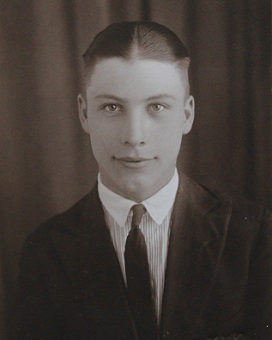
Leonard Krall (L.J.) was the youngest son of J.J. and Anna Krall. While acquiring skills as an optician he married Kardena Gilbertson in Tyndall, SD in 1922. It was a union of diverse backgrounds, L.J. (as he was commonly called) came from a traditional home, and Kard (as she was nicknamed) was the child of a blended family. Having lost her father at a very early age, she was sent to live with her grandmother while her mother found work as a seamstress. Kard's life with her strict Norwegian grandmother was hard, but she was an excellent student and she took an interest in education. She eventually graduated from Springfield Normal College with a teaching certificate in the early 1920's.
After the couple were married, they headed to the Black Hills in a Model T for their honeymoon! Early in their married life, L.J. traveled the South Dakota countryside selling and tuning pianos, but eventually "Kard and Len" settled into life with the family Optometric business. L.J. joined his father and brother in practice in 1929.
In 1946 Leonard's younger sister Barbara also joined the practice. By this time Kard and Len had two children, Marilyn and Charles. The couple spent the early 50's working to build a business and raising their family. Their eldest child, Marilyn, followed the family tradition and became an Optometrist graduating from the Illinois College of Optometry in 1951. While in school, Marilyn met and married fellow Optometrist Earnest Allen and they moved to his home state of New Hampshire where they built a practice of their own.
Much to Kard & Len's delight their youngest son, Charles, followed in the family footsteps and also graduated from ICO. There he met and married a native of Chicago, Carmela Stefanelli. Dr. Charles brought her home to South Dakota and together with Leonard and Kardena, they lived and worked side by side for over 40 years. L.J. was the clinics' chief optician and his skill at making lenses and frames was only surpassed by his ability to provide patients with "just the right fit." Kardena kept the books with mathematical precision. Together with their son and daughter-in-law they became an inseparable team. From time to time, when their schedule permitted, Kard and Len traveled the globe. In their later years they built a winter home in Florida.
Leonard John Krall passed away on February 13, 1995 at the age of 93. He worked every day at the clinic until just a month before his death. Kardena died in February of 1998, living until the age of 96.
Source: Krall Eye Clinic
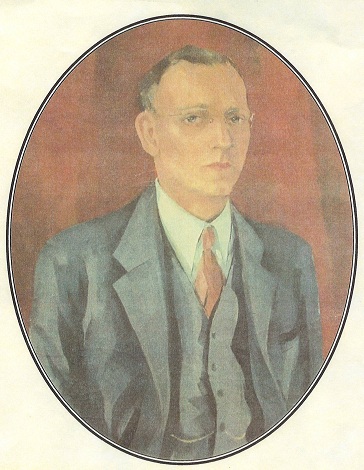
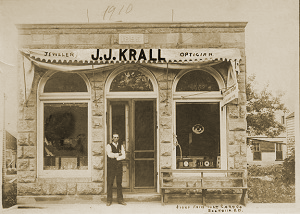
J.J. Krall was born in 1876 in Prague, Czechoslovakia. He set out to begin a career, which now spans 4 generations.
At the turn of the century, J.J. set his sights on starting an Optometric Practice in a place where the population was rural and isolated with little extra money for luxury's like medical services. However, J.J. was undeterred and went off to Chicago in the late 1800's to procure a degree in Optometry. After graduating in 1900, he also acquired skills as a jeweler, piano tuner and watchmaker - just in case he needed to diversify. To say that the young Dr. Krall was ahead of his time is probably an understatement. He was an astute marketer and understood the value of letting the public know about the variety and quality of his services. That entrepreneurial spirit is evident by the many advertisements he produced to market his practice.
J.J. and his wife Anna raised five children, William, James, Leonard, Mary and Barbara. They saw to it that each child received a formal education in the career of their choice. William, like his father, attended the Illinois College of Optometry, graduating in 1922. James became a career navy man, retiring with the rank of Lieutenant. Leonard, father of Dr. Charles, studied to be an optician under the tutelage of his father and older brother J.J. Barbara graduated from ICO in 1945, and joined her father and brothers in practice. And Mary, who studied in Pais & Europe, became a talented artist which brought her much acclaimed recognition throughout her life.
J.J. was also a community man and elected Mayor of Tyndall , South Dakota in 1922. He was a founding member of the South Dakota Board of Optometry, and through his life was a dedicated and involved citizen. Dr. James Joseph Krall died in Mitchell in 1962 at the age of 86. His wife Anna lived until 96, passing away in 1987.
The legacy of his tireless commitment to his profession, his community and his family, is one that generations of the Krall family continue to emulate.
Source: Krall Eye Clinic
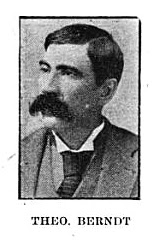
THEODORE BERNDT, representative from Bon Homme Co. was born in Old Danzig, South Russia in 1860, left Russia in 1876, and came to Bon Homme County, SD the same year. Remained in Bon Homme County till fall of 1877. Then went to Illinois and worked on farm near Jefferson Ill. till spring 1879, then went to Lake Superior. Worked at iron mining till March 1882, then returned to Bon Homme County and engaged in farming till 1890, then went in Indian service at Cheyenne Indian Agency till 1892. Then engaged in grain business till 1893. Traveled as salesman and collector for the Piano Mfg Co. of West Pullman, Ill. from 1893 till fall of 1901, then engaged in farming again in Bon Homme County, SD. Was elected as a democrat.
Source: South Dakota Legislative Manual, Volume 8 ~ 1903
written by Magdaline (Berndt) Van Asperen
Ephraim R. Berndt was born on the homestead of his parents, Michael and Anna Marie (Radack) Berndt, west and north of Tyndall, South Dakota.
Ephraim homesteaded in Ziebach County about 1915, 8 miles southeast of Eagle Butte.
We still have his papers where he was allowed lots 1 and 2 and the south half of the Northeast quarter and Southeast quarter of Section one (1) in township 11, North of range 24, east of Black Hills Meridian, containing 320.27 acres more or less. This was allowed June 9, 1915, and on October 6, 1920 made final proof.
On January 18, 1917, he married Lydia Hubner, daughter of Andrew and Magdaline (Newhart) Hubner of Avon, South Dakota. I am Magdalene Marie, Ephraim and Lydia's first child. I was born in March of 1918 out on that homestead, some eight miles south and east of Eagle Butte. Dr. W. J. Jacoby was my doctor and Mrs. William Shannon my nurse. Mrs. Shannon's son's name was Otis. I first met Otis in 1934 when I was in Eagle Butte to visit my aunt and uncle, Emma and Emil Berndt and family and my uncle Ed (Kelly) Berndt, who was a carpenter there for many years.
I remember our frame house, a barn or cattle shed and a cave as the main buildings. I remember Dad telling about the trouble he had getting Dr. Jacoby across the creek the day I was born. The doctor fell in, and they had as much trouble getting him dried out and warmed up, as he had delivering me.
I don't remember much about that country, but I sure won't forget the rattlesnakes. I'm still scared stiff of snakes, and even hate a tiny worm if it crawls like a snake.
Dad always said there was a prairie dog town on the next hill near our home and that prairie dogs and rattlesnakes lived together, so I was never left alone outside to run and play.
I remember the folks talking about all the good neighbors they had, some of the names I remember were Meyers, Holloways, Kecklers, Pearlefines, Darlings, Pritzkaus (Adolph Pritzkau's folks), Hinzmans, and Albert and Francis Berndt, Jack Burbeck and I remember Dad talking about the Diamond A Cattle Company, Archie Wells and Ernst Eidson.
There was a store in Eagle Butte, known as Cady and Austins and Naeve's. We traveled there by horse and buggy.
I remember riding in the train back to Avon to visit my grandparents. The train traveled so fast and had red plush seats.
Dad dreamed of a big ranch someday. Mom got so homesick they had to leave for her healths' sake.
Our biggest hardship was on March 18, 1921 (I believe that was the year) when a mean wet kind of blizzard hit. The day had been beautiful and warm, the cattle were bedded down near the shed and during the night the storm came up. The cattle drifted with it, their eyes and noses were covered with the wet snow and then froze and smothered the whole herd.
In June, my sister, Carol June was born, and in November my mother's father died, so during that fall or winter we moved back to Avon to run the farm for Grandmother Hubner.
My brother Michael was born in 1925; Donald in 1933 and Freddie in 1935.
Our mother died May 11, 1936 at the age of 37 years. Little Freddie died in 1938.
In 1960 Dad and Uncle Emanuel Hubner made one more trip back to Ziebach County to attend the Golden Jubilee. Dad took his two grandsons with him and they had a grand time seeing the old homestead land and staying with Uncle Adolph and Aunt Margaret Hubner in Dupree.
Dad remained on the farm until 1963 when he retired and moved into Avon where he died in 1969. He was a wonderful father. We were so fortunate to have such wonderful parents.
Source: South Dakota's Ziebach County: History of the Prairie ~ 1982
written by Pansy Hinzman Hebner
My Dad, E. W. Hinzman of Avon, South Dakota, went to Eagle Butte to homestead in 1910. His homestead was about eight miles southeast of Eagle Butte, in Ziebach County. The description of the homestead was S. W. 1/2 of Section 11, Township 11 and Range 24.
After he built a homestead shack he came after Mother and us three children, Clarence, Sylvia and me, Pansy.
Our stay at the homestead wasn't too long, but I was too young to remember how long it was. Because of the failing health of Mother, we moved back to Avon, South Dakota. Mother passed away soon afterwards and was buried at Danzig Cemetery at Avon, South Dakota.
In 1916 Dad married Emilia Aldenger of Turtle Lake, North Dakota and in 1917 we moved back to the homestead at Eagle Butte, South Dakota. Dad bought more land and raised cattle. Didn't do much farming as it wasn't a farming country. Here two of my half sisters were born. They were Ruth and Mabel.
Clarence, Sylvia and I attended country school there. It was hard to get teachers and if they got one, sometimes they didn't finish out the term.
In 1920 Dad bought land about two miles north of Eagle Butte in Dewey County. After a house and some other buildings were built, we lived there. My other two half sisters were born here; Iona and Viola.
It was here we lived and went to Eagle Butte town school, graduated, and later married and left home.
I married Albert Hebner of Avon, South Dakota; Sylvia, Clifford Ralston; Clarence, Marie Angel (first marriage), Mabel Heideman (second marriage); Ruth, Lee Garrett; Mable, Clarence Sporer; Iona, Melvin Bringman; all of Eagle Butte area. Viola went to California and was later married there to Robert McDowell.
Dad and Mother lived there until 1945 when they retired and moved to Eagle Butte. Dad passed away in 1958 and Mother in 1962. Both are buried in Eagle Butte cemetery.
Source: South Dakota's Ziebach County: History of the Prairie ~ 1982
written by Louise Hinzman Bringman and Paul Hinzman
Our parents, Alex and Johanna (Radack) Hinzman came to Ziebach County in 1912 to establish their homestead south of Eagle Butte, on the SW 1/4 Of Section 3 Range 24 Township 11.
Fourteen families and bachelors came from Avon, South Dakota on an immigrant train, which carried their livestock, farm supplies and household goods. The families who came were the Emil Hinzman's, Alex Hinzman's, Emanuel Hinzman's, Emanuel Buchholz, Jake Pritzkau's, Emanuel Pritzkau's, and Rudolph Berndt's. The single men were Henry Giedd, Ed Giedd, Emanuel Hebner, Jack Burbick, Emanuel Brokofsky, Ephraim Berndt and Ted Hinzman. All of these people settled on Township 11, Range 24.
They began building their homestead shacks on their individual quarters of land. Family claim shacks were as big as 20' by 24', but many bachelor shacks were no more than 10' by 12'. Most families either had a dug out cellar or a cave, a refuge from storms and useful cool storage.
Mother and children came in May 1912, because their two year old son, Harold, was recovering from burns. Louise was 6 months old.
Water was dipped from natural ponds until one family dug a well for use by all of the homesteaders. Breaking sod and plowing fire guards was done by helping each other. As they were plowing fire guards around their own quarters, they decided to plow for a widow neighbor lady, who wasn't at home at the time. When she discovered it, their charity wasn't appreciated. She demanded that they turn all of the sod back with a hand shovel.
There were no line fences then. When the cows would get out, they would go back to the Eagle Butte stockyards where they had been unloaded. They must have been homesick too.
Soon a school was built by the men of the community. The one room frame building was on the quarter owned by Henry Giedd and later was ourpermanent home site. The Giedd school continued to serve the children of that area for over 40 years.
Pioneer life was hard for the wives and mothers. With a neighbor on the next quarter the ladies often walked for a visit. Social get togethers were frequent. We wonder how they accommodated the crowds in their small frame homes.
A traveling Baptist minister would come for a time and hold services either at the schoolhouse or in homes. He always stayed with the families. Mother told of having to arrange sleeping space for the minister, a visiting family of four and our own family in our small two room house. Louise slept in a dresser drawer and Harold on top of a trunk. Cots were set up and everyone had a comfortable night's sleep.
A close bond developed in their small community because of the struggles and sorrows they shared. Mother told of attending to the burial preparations for a baby nephew, Gordon, the son of Mr. and Mrs. Emil Hinzman. The mother handed her the baby and she bathed and dressed him while the men got the little wooden casket. Mother and Dad put the baby in his coffin in the cave to keep cool before the funeral. His grave is on the quarter of land now owned by Mary Hinzman.
Fourteen months were required as "proving up" time on the homesteads. Because of the drought and hardships, most of the families returned to Avon after fulfilling their obligations.
Our parents moved back to Avon in 1913 and lived there until 1924. Then we moved back to make our permanent home on the Henry Giedd place. More than a quarter of land was needed to make a living. Our original homestead house is still standing there.
Irvin and Paul were both born while we lived at Avon. Irvin died in January 1926 when he was 10 years old, and our father died three years later, in January 1929.
Harold married Mary Deirmeier of Avon in 1936, and they had two children. Louise married Earl Bringman in 1951 and they had one daughter. Paul married Shirley Mader in 1948 and they have eight children. Harold, Paul and Louise all lived on ranches in the same area until they respectively moved to Eagle Butte to live, but keeping their ranches. Louise's daughter and son-in-law, Pauline and Gene Webb own hers now. Mother passed away in 1968 and Harold in 1971.
Source: South Dakota's Ziebach County: History of the Prairie ~ 1982
World War I cost Daniel June Cass his shot to play in the Major Leagues.
Born in Scotland, South Dakota June 25, 1894, Cass hit .336 in 28 games for the Des Moines Boosters in the Western League in 1916. After hitting .284 the following season with Des Moines Cass was purchased by the Washington Senator.
Cass joined the Senators in Augusta, Georgia for Spring Training and according to the Associated Press was set to make the Clark Griffith’s team, but for his draft status:
“Based on the fact that he is in class 1 of the draft and his number in the order of liability is so low, being in the first 400, that there is no assurance he would be able to remain with the Griffmen more than a month or two…if retained the Washington club would have to pay $3000 for Cass under the agreement with Des Moines, and the pilot (Griffith) figures it would be poor business policy.”
Although the article went on to say Cass would probably not be able to displace any of the starters, his speed alone would have benefitted Washington’s aging outfield. (No stolen base records survive for his Western League tenure, but Cass was always mentioned as one of the best base stealers in the league in contemporaneous newspaper accounts).
Cass was returned to Des Moines and hit .327 in 24 games before reporting to Great Lakes Naval Training Station in Illinois on June 6. Cass served the remainder of the year.
Cass returned to Des Moines for 1919 season, and got off to a good start hitting .308 and leading the league in stolen bases through 80 games. It was also reported by the Associated Press that the Senators again had an interest in purchasing Cass.
In late July 0f 1919 Cass developed a case on tonsillitis, developed quinsy and died on July 28.
Source: Baseball History Daily
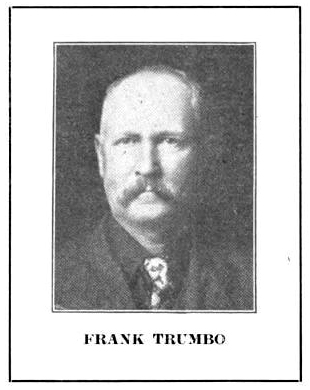
THE TERRITORIAL PIONEERS
ADDRESS OF HON. FRANK TRUMBO, AT THE BIENNIAL MEETING,
JANUARY 23, 1909
Mr. Chairman and Members of the Historical Society, and Ladies and Gentlemen;
At the request of your secretary, that I should relate some of the happenings incident to the early settlement of the territory of Dakota, I have written the following letter. I will only speak of territorial days, as most of our citizens are familiar with the period since statehood. I came to the territory about June first, 1862. I was then eleven and a half years old. About the first inhabitants I met were the genuine Americans, the Sioux Indians. They were not civilized at that time, but were reported to be friendly, and greeted us in such a manner as to leave with us the impression that they were not as savage a race of people as we had expected to see, and that if we treated them right that they would treat us the same as far as their ability went along that line. I allude to the Yankton Sioux as they have always proved themselves friends of the palefaces. The first body of Indians of any number I met, that is, in the way of a friendly and social meeting, was at Vermillion some time in June, 1862 where we had taken up our residence. There was perhaps one hundred of them camped in the willows along the Vermillion river near the town. A man by the name of A. C. Vanmeter who, by the way, had a mixed blood Indian wife, and as he could speak the Sioux language and was well known to these Indians he invited me to go with him and see the Indians. At first I hesitated, but upon his assurance that they would do me no harm, I went with him and saw them in their real camp life, and there I learned my first Indian word which was the name of one of the brightest most intelligent men for an uneducated Indian that I have ever known among my acquaintance with Indians. This man was Etehota or Grayface. He certainly was a great friend of the paleface, or Wasice as the Indians call us white folks.
These Indians were on a visit to Mr. Vanmeter and others that had lived along the banks of the Missouri river from Yankton to a point below Sioux City. During the time that the Indians had lived there before the treaty was made with them in 1858, when they were moved to Charles Mix county, on the four hundred and thirty thousand acres reserved for them where they have since resided. The eithteenth day of August, 1862, occurred the Minnesota Indian massacre participated in by the Santee Sioux, the most of us settlers fled for our lives from Clay county. We went down near Adell, Iowa where the country was thickly settled, remained there until November, and as the Indians had become quiet we returned to Vermillion, Clay county, there was eleven in our family consisting of father, mother, and nine of us children: six boys and three girls. My three older brothers enlisted in the army: brother John in the First Dakota cavalry, Company A, Captain Miner's company; brother William in the Second Dakota, cavalry Company B, Captain Tripp's company; brother George in the Iowa Seventh. These companies were raised in the winter of '62 and spring of '63 for the purpose of protecting the frontier against the hostile Indians, and were under command of General Sully. As I was too young to be a soldier, I joined the home guards of Clay county, which were organized for home protection, had a government gun called a Carbine issued to me. There was really more danger behind these Carbines than there was in front of them. I had seen plenty of kickers in my time, but nothing to compare with those guns. I was hunting one day and had shot at several coyotes and had not succeeded in killing any, and as my shoulder was so lame from having fired the gun several times during the day, and as I desired to return to my home and did not want to leave the gun in the house loaded for fear it might go off and kick the house to pieces, and as I did not see any coyote to fire at, and did not have the courage to fire it off in the air, I tied it to the corner of a rail fence and pulled the triger. Oh my, you ought to have seen that fence. It took me a whole half day to rebuild it. So that is the kind of weapons of defense that we home guards had to defend the defenseless women and children with. I think, however, that those guns would have been all right for men weighing 250 or 300 pounds but they certainly were too strong for us boys. I always felt how fortunate we were that the Indians never attacked us, as there certainly would have been lots of persons wounded, perhaps more whites than Indians. The spring of '63, while my soldier brothers were away up the Missouri river with General Sully, our father died and in the fall same year before they returned our mother also died. I was then thirteen year old, being the oldest boy at home I had not only to watch for Indians but had also to look out for every little job of work I could get to do to earn money enough to buy corn meal to feed the six of us that yet remained, one elder sister and five of us younger children. Water was free, and it was fortunate that it was, for it took every cent of our earnings to buy the meal which we mixed with the water to the proper consistency for baking in to corn bread, and this corn bread, with the addition of black strap molasses, constituted our regular bill of fare. I have often thought perhaps it was well that we hadn't more good things to eat, as we might have made ourselves sick, and as there were no doctors; oh yes! we did have one doctor what we called an almanac doctor, that is, he learned to practice medicine from studying Dr. Jayne's almanac, and he seemed to be quite successful, too, that is I never heard of his being charged directly with having killed anv of his patients. After my brothers returned from the army in '65, my oldest sister, then of age, took the younger children with her and went back to Iowa where she was married and settled on a farm. I was then fifteen years old and, of course, had to paddle my own canoe. My brother, John, and I engaged in farming.
We rented a farm about three miles from Vermillion, forty acres which had been plowed the year before, and as it had not rained during the summer of '65 there had no weeds, nor anything else, grown on this land so it looked like fresh plowing. So I told my brother John that there was no need of plowing this ground, but to furrow it out with the plow, and I would drop the corn in the furrow, and he could cover the seeds with the plow, so we did it in this way, and planted the whole forty acres to corn. We waited all summer for our corn to come up, but it never made its appearance, and upon investigation about September first we found the seed just as we had planted it, dry as a bone. It had not rained one drop during the summer of '66, there was no hay to be had on the Missouri bottom where it grew in after years as high as six and seven feet, the saying that it never rains in Dakota I think started that year. After that '67, '68, and '69 we had rain and grass, and what crops were planted grew fine demonstrating that the soil was rich and would produce abundant crops of nearly all kinds of grain. But the grasshoppers came and they destroyed everything. People got discouraged and left the country, and it looked as though we never would get a foothold. I left Vermillion August 1, 1869, and went up to Charles Mix county among the Indians at Greenwood, where I secured employment from the government, commenced at the bottom of the ladder and worked up, held the positions of superintendent of government cattle herd, issue clerk, and superintendent farmer. Worked in all eleven years, in the meantime, I took a pre-emption on the Emanuel creek about three miles from the city of Springfield in Bon Homme county. I proved up on this claim in '72, and took me a homestead on the beautiful little Choteau creek just across the line from Charles Mix in Bon Homme county, Spring of '73.
Then I went and got married, took my wife right out among the Indians three miles from the agency where I was camped with the cattle herd and Indian herders. My wife and I would go occasionally and stay on our claim just enough to hold it, no one bothered our claim. No one at that time would have accepted a deed to a quarter of land as a present unless the doner would have agreed to pay the taxes. My wife and I quit the agency in '74, and moved on to our homestead, thought we would make more money farming than we were making as the grasshoppers had kind of let up. So we put in a big crop in '74 and we had a nice little start in young cattle, pigs, and chickens, but the grasshoppers came in August and ate everything we had in the way of crops, so we had to sell our stock in order to live. The next year we put in another big crop, and had just got through cultivating for the last time July 1st when the Indian agent came from Greenwood and employed me to go back as his boss farmer. So we were glad to go back where the crop was more sure. We had not been there more than a month when the grasshoppers came again, and they made the cleanest sweep they ever made, even ate the sunflowers and the leaves and bark off of about fifteen hundred little cottonwood trees that she and I had planted that spring. I remember she and I drove down to the farm the next Sunday, after the hoppers had destroyed the crop, and the looks of things around the farm was too much for my wife, she began to cry. I said to her, "What are you crying about, you ought to be thankful that they left us the house, barbed wire fence, and the mortgage." We sold the stock we had left to pay up the debts we could and worked at Greenwood for two years more till finally the grasshoppers ceased to make their appearance then we went back on the farm, but we had drouth, rust, hog cholera, low prices, and sickness to contend with until we finally rented the farm and engaged in other business which we found was more remunerative for us. Finally sold the farm and invested in cheaper lands. But I will say this that for the past six years the crops have been fine all over our state, and prices have been good so that the farmers have made money, and that the farm today is the most remunerative most independent and the pleasantest place to live of all places I think. To show you how little we people valued land here in the early day, 1874, I will tell you that I traded my pre-emption 160 acres, three miles from Springfield, deeded land for a span of horses and harness worth about two hundred and fify dollars ($250.00). I traded with the Hon. James H. Stevens. By the way, he was in the senate from Bon Homme county four years ago. When I traded my land to him for the team, I did not ask him to throw in the halter for fear he would back out. I had a homestead and I needed a team to farm it worse than I needed the pre-emption. That land is worth eight thousand dollars ($8,000.00) now and will be worth one hundred dollars per acre in a few years. You all know that South Dakota is a great state, hardly excelled by any other state in the union. Millions of dollars worth of wealth, on every hand, prosperity, contentment, and happiness. And all this has been brought about in these few years, say about fifty and forty-seven of them. I and my wife, who has been a resident also of Dakota for forty-six years, have been doing everything we could in our humble way to help build up and make this great commonwealth what it is today. To us and all old settlers for the very important part we have played in the development of the country is certainly deserving of great credit, and if I do say it myself, I mean every word for it, and I sincerely hope that neither of us nor any of our children will ever see or have to go through the hardships, the suspense, the grief from loosing parents, the fear of the Indians, failure of crops that we early settlers had to go through.
Now, in conclusion, I want to tell you of a hunt that the Yankton Indians, I in charge of them, went on the first day of August, 1872. We went from Greenwood, Charles Mix county, crossed the Missouri river and went in to what is now Gregory, Tripp, and Meyer counties. We went out with the expectation of killing buffalo, but were disappointed as other Indians who were roaming that country in those days got the buffalo. We only succeeded in getting one buffalo and five buffalo calves. However, we killed eight hundred deer and antelope and fifty-five elk. I must have seen on that trip at least five thousand deer and antelop. Where today the evidence of the white man is to be seen on every hand in the form of cultivated fields of golden grain, beautiful groves, beautiful homes, and happiness and contentment reigns supreme: the antelope, deer, elk, and the buffalo are of the past and will soon be forgotten, but my, the multitudes that are being fed from the products taken from that very soil where thirty years ago game was the only inhabitants of that country which no one thought was good enough for anything but game. A great change indeed beyond the expectations or anticipations of anyone and South Dakota is not yet half developed. She is going to keep right on, and I predict that she will be one of the greatest, if not the greatest state, in the union in a few years. I have only tried to tell you of a few of the incidents and happenings of the early settlement of Dakota. I have skipped and omitted many interesting occurrences for the want of time and space. When I started to write, I only intended to write just a few of the really interesting incidents, but I find that my letter is now already too long and I must stop.
I thank you all for your kind attention.
Source: South Dakota Historical Collections, Volume V ~ 1910
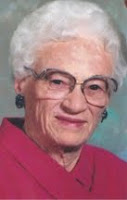
Czech Days 2012 Dedicated to Vivan Vaith
Tabor’s 64th annual Czech Days celebration is being dedicated to the late Vivian Vaith during ceremonies on Friday, June 15, 2012 in Sokol Park at 3:00 p.m.
Vivian was born December 13, 1918 in Tabor to John and Anna (Boxa) King. She grew up in Tabor with her four sisters, Lorraine (Leo) Karolevitz, Georgianna (Fred) Reichert, Caroline King, and Genevieve (Robert) Hoyt and her one brother Harry King.
Vivian graduated from Tabor High School in 1936 and then went to work at the former State Hospital in Yankton (now the Human Services Center) as a psychiatric aide until her marriage on January 7, 1943 to her high school sweetheart, Frank Vaith. Vivian and Frank resided in Tabor their entire lives where they were both dedicated to their community.
After her marriage she enjoyed being a wife, homemaker and mother to their two daughters, Kathy (Don) Kortan and Deb (Gary) Caba. She enjoyed her six grandchildren Chris, Scott, Nick Kortan and Jennifer (Kortan) Mills and Brian and Amy Caba. She loved following their sporting and school events and having them spend the night at her home. Eleven great-grandchildren have been added to her legacy.
Vivian was a member of St. Wenceslaus Catholic Church and Altar Society. She was a devoted member of the Kortan-Hatwan American Legion Auxiliary where she served in various offices and leadership roles-always showing her pride and support for the US military.
Vivian and Frank were long-time members of the Beseda Club traveling to many area festivals and events to share the Czech dance and heritage.
She was instrumental in organizing the Tabor Senior Citizens organization, promoting and working for its success with delivery of meals to the homebound residents of the community.
She and her sister Caroline with a group of other Tabor women sewed and dressed hundreds of little Czech dolls, which they offered for sale to promote Czech Days and their heritage. She enjoyed needlework (having made quilts and Afghans for each of her grandchildren), playing cards, and spending time with family and friends. She was always ready to give of her time and talents to the community.
Vivian died on January 25, 1999.
Tabor’s 66th annual Czech Days celebration is being dedicated to the late Josie Kutilek during ceremonies on Friday, June 20, 2014 in Sokol Park at 3:00 p.m.
Josephine “Josie” Kutilek was born east of Tabor to Frank and Mary (Koupal) Hale on September 12, 1917. She passed away on May 1, 2011. Josie married Emil Kutilek on January 4, 1937. Josie and Emil raised four daughters: Marlene (Ervin) Syrovatka, LaVonne (Ken) Yule, JoAnn Kutilek and Jeanene (Darrell) Edelman.
Josie and Emil ran Emil’s Bar in Tabor for 21 years. They were big promoters of Czech Days which was a big thing for her. They went on booster trips from town to town advertising Czech Days a couple of weeks before Czech Days.
Josie and Emil had lots of friends from Nebraska and North Dakota that stayed at their house during Czech Days. Al Grebnick, a Polka Band, from Schuyler, Nebraska stayed at their house when his band played in the bar during Czech Days. In 1997 Josie and her daughter Marlene and great granddaughter Cindy Syrovatka had the first Kolache Baking Demonstration for Czech in the Community Center. Josie had the demonstration for six years. Josie loved gardening and embroidery. She baked kolaches and rye bread for people even when she lived in Lidi Apartments in Tyndall, South Dakota.
Josie loved to dance and taught a lot of her grandchildren how to dance. Her daughter LaVonne was Czech Days Queen. Granddaughters Norma Rokusek, and Karen Evenson and Great Granddaughter Cindy Syrovatka were also Czech Days Queens.
She was a member of St. Wenceslaus Catholic Church, Altar Society, Czech Heritage Preservation Society and a great promoter of the Tabor Bluebirds Baseball team.
Josie was the Czech Days Parade Marshall in 1996.
Josie’s family declares Czech Days a National Holiday every year.
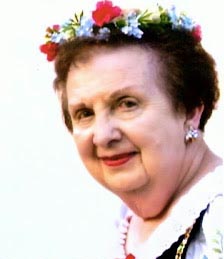
Tabor’s 67th annual Czech Days celebration is being dedicated to the late Mildred Cimpl during ceremonies on Friday, June 19, 2015 in Sokol Park at 3:00 p.m.
Mildred Anne (Schuch) Cimpl was born on January 30, 1932 to James and Anna (Bouska) Schuch in rural Tabor, SD. She had a very devout faith and was a lifelong member of S. Wenceslaus Catholic Church in Tabor. Mildred attended St. Wenceslaus Parochial Grade School then went on to graduate from Tabor High School in 1949. She married Leonard Cimpl on May 28, 1951 at St. Wenceslaus Catholic Church in Tabor. Mildred and Leonard had three children: Fr. Chuck Cimpl, Joe Cimpl and Sue (Mike) Stoll. Mildred passed away on March 31, 2013.
Mildred began working at Cimpl’s Market in Tabor during her high school years. She met her husband Leonard while working there, and she and Leonard worked together in the Market for 35 years.
Mildred was very involved in many church, community, and charitable activities. In her church she was a Choir member, lay minister of Communion, and member of the St. Wenceslaus Altar Society. Her community involvement included a member of the Tabor Chamber of Commerce and Chairperson of the Bon Homme County Food Pantry. She was also a member of the American Legion Auxiliary. Her Czech heritage was very important to her. From the time she was 8 years old, she danced the Beseda and later went on to teach the dance with her parents to others. She was a member of Czech Heritage Preservation Society and was prolific in the Czech language throughout her life. She was an actress in the local Czech plays and taught the Czech language to youth in the community.
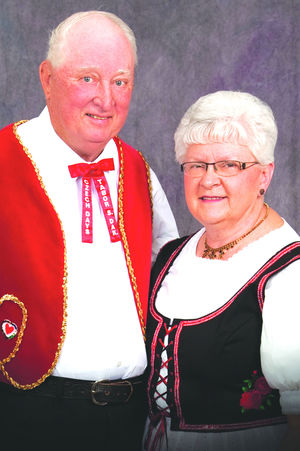
The Tabor Chamber of Commerce is happy to announce the selection of Darrell and Ann Beran as the 2015 Tabor Czech Days Parade Marshals to lead the 67th annual Czech Days Parade on Friday June 19th at 1:00 p.m.
Both Darrell and Ann have been Tabor area residents all of their lives. Darrell was raised on a farm Southeast of Tabor and Ann was raised on a farm East of Tabor. They were married on October 12, 1968.
Darrell’s parents are Emil and the late Evelyn (Blachnik) Beran of Tabor, and Ann’s parents are the late Henry and Vincie (Carda) Adam of Tabor.
Darrell attended Elm Grove Country School and graduated from Tabor High School in 1961. From there he attended Southern State Teachers College at Springfield for Automotive Repair.
Ann attended St. Wenceslaus Grade School in Tabor and graduated from Mount Marty High School in 1964. From there she went on to Washington Senior High School of Practical Nursing as an LPN. She worked at Sacred Heart Hospital as a nurse for a few years and then stayed at home to raise their family. After her children were grown, she returned to nursing for almost 30 years.
Darrell farms with their son, Brian and family Southeast of Tabor. He retired with 21 years on the Tabor Fire Department and is currently a Director of the Bon Homme Yankton Electric Association in Tabor. He is a member and past Commander of the Tabor Kortan-Hatwan American Legion Post #183, member of the Tri-State Old Iron Association in Yankton where he has enjoyed participating in the WNAX Tri-State Old Iron Antique Tractor Ride.
Darrell and Ann are members of St Wenceslaus Catholic Church, where Ann volunteers for the church, and served on the Church Council. She is a member of the Altar and Rosary Society and a past officer. She also volunteers for various organizations in the Tabor Community. She enjoyed participating in the Czech Plays for the Czech Heritage Preservation Society, along with Darrell in the past.
Ann has conducted the Baking Demonstration at Czech Days, along with family members for the past 11 years. Last year she did a video teaching the art of making Kolace and Rohliky which she hopes will encourage others to continue this very important tradition.
They both enjoy traveling to Czech festivals and attending other community celebrations throughout the neighboring states where they have met wonderful people and have always promoted the community of Tabor of which they are so proud to call home. Darrell has their parade chairs ready in the trunk of the car starting in the spring as he plans their annual adventures. They also love going to their grandson’s activities and sporting events.
Darrell and Ann have two children, Brenda Beran of Sioux Falls; & Brian (Amy) Beran, grandsons Braden & Maxwell of Tabor.
Source: Tyndall Tribune & Register ~ May 27, 2015
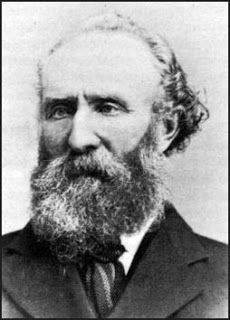
Charles Thomas Campbell was born 10 August 1823 in Franklin County, Pennsylvania. He was educated at Marshall College. When war broke out with Mexico in 1847 he entered the army as a 2nd lieutenant in the 8th US Infantry. He was promoted to captain in August 1847 and mustered out of service in 1848.
In 1852 Campbell was elected to the lower house of the Pennsylvania legislature. At the outbreak of the civil war Campbell helped recruit a company of artillery in Franklin County. He was named captain. The company became part of the 1st PA light artillery, also known as the 43rd PA or the 14th PA Reserves, which was formed following a call for volunteers by James Brady of Philadelphia on 13 April 1861. The regiment was the 43rd formed in Pennsylvania. It also was the 1st artillery regiment and the 14th regiment formed after the legislature passed and Governor Andrew G. Curtin signed legislation on 15 May 1861 establishing the "Reserve Volunteer Corps of the Commonwealth."
When Captain Richard H. Rush of the regular army who had been made colonel and given command of the 43rd PA, declined to accept command in the Reserve Corps, and subsequently was commissioned a colonel in the regular army attached to the 6th US Cavalry, Campbell, who had been promoted to lieutenant colonel was elected colonel and new regimental commander. He remained with the 43rd only until December when he took command of the 57th PA Infantry. He commanded the 57th at Fair Oaks where his horse was shot out from under him and he received two severe wounds. He was appointed brigadier general of volunteers in November of 1862 but the appointment expired. He again led the 57th at Fredericksburg where he was again severely wounded and left for dead.
His wounds prevented further active service but Campbell was promoted to brigadier general on 13 March 1863 and given command of the Wisconsin District. In 1866 Campbell relocated to South Dakota working as an Inspector of Indian agencies. In 1870 he established a stagecoach stop along the Firesteel Trail. This stop, which included his residence, an inn, a general store and a large horse barn became the town of Scotland, South Dakota. Campbell who became active in Democratic politics served as mayor of the town he created. He also ran a hotel. Campbell died 15 April 1895 in Scotland, South Dakota.
Sources: CivilWarInteractive.com & Wikipedia.org
Gen. C. T. Campbell was born in Pennsylvania in 1823; he served in the United States army during the war with Mexico. Also served in the late rebellion; General Campbell has a great many battle scars that he will carry to his grave; he left the service in 1866 with rank of brigadier general; that same year he moved to Dakota and settled 15 miles above Port Randall, on the Missouri River; in 1871 he moved to the James River Valley and settled where Scotland now stands. He married Miss South, of Baltimore, Md.
Source: History of Southeastern Dakota, Its Settlement and Growth ~ 1881
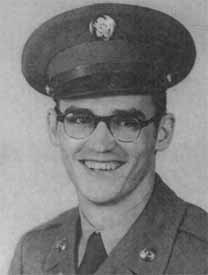
Richard Bruce Van Buskirk was born in Huron, South Dakota, on November 4, 1928 to Ralph H. and Elva (Lytle) Van Buskirk. He had one older brother, Oral. Richard attended high school in Scotland, South Dakota, where he was involved in football, track, and basketball. He graduated from Scotland High School in 1947. After school he ran Dick’s clothing store and helped his parents at the DeLux Dry Cleaning business. Richard was an active member of the Scotland Fire Department, and the Moose Lodge in Scotland. He was married to Leona Orth on June 13, 1948, in Scotland, South Dakota.
Richard Bruce Van Buskirk enlisted in the 196th Infantry National Guard Unit of Yankton, South Dakota, on June 24, 1948. He was put on reserve status on September 21, 1949, and then recalled to active duty into the army on December 12, 1950 at Fort Riley, Kansas. After Cpl. Van Buskirk came home on furlough in April 1951 he was sent to Fort Lawton, Washington. Soon after, he shipped to Korea, arriving there on June 15, 1951.
Corporal Richard Bruce Van Buskirk was killed in a Korean battlefield on the afternoon of September 11, 1951, one day after returning to the front lines from a rest camp. Fragments from an exploding mortar shell struck Cpl.Van Buskirk while he was acting as a radioman for his unit commander during an attack on enemy held positions.
Cpl. Richard Van Buskirk, a member of Company K, 31st Infantry Regiment, 7th Infantry Division was buried in Scotland, South Dakota, on December 17, 1951. Corporal Richard Van Buskirk was awarded the Purple Heart, the Combat Infantryman’s Badge, the Korean Service Medal, the United Nations Service Medal, and the National Defense Service Medal.
Source: South Dakota Korean War Memorial

John “Katy” A. Ptak was born on December 4, 1918, at Tyndall, South Dakota, to Frank and Mary Ptak. He had a brother, Ray, and a sister, Patsy. John was raised and educated in Tyndall, where was known for “his outstanding ability as an athlete.” He graduated from Tyndall High School in 1936 and from the University of South Dakota in Vermillion in 1940, having been “a basketball regular with the Coyotes and was awarded six letters in basketball and track.” While at USD, John was a cadet officer in the ROTC and was one of the top three ROTC candidates. In the same class at USD was Joe Foss, another of South Dakota’s war heroes.
On June 15, 1940, John Ptak entered active service at Vermillion. He entered the Marine Corps on July 15 at the Navy Yards in Philadelphia, Pennsylvania. Ptak received his commission as a second lieutenant in February of 1941. Lt. Ptak was then stationed in Iceland for eight months. On August 16, 1942, John married Dorothy Walters in La Jolla, California. On January 24, 1943, Lt. Ptak was sent overseas to the Pacific theater, where he was promoted to the rank of major, and named Commanding Officer at Camp Tetere, Guadalcanal.
In the time preceding his death on Guam, Major Ptak was involved in “some of the toughest Marine Drives.” One war correspondent in a radio broadcast said that after already engaging in “58 hours of the most vicious fighting,” Ptak’s company had to climb a ridge that was “almost perpendicular and looked like a superhuman job.” He goes on to report, “Despite the terrible odds, the only order given was ‘attack,’ and so they attacked once, twice, three times, and every time the casualties mounted and the size of the company dwindled pitifully.” After this engagement, Major Ptak said he’d “never know how the marines held on. But they did.” In accomplishing the objective of taking the ridge, “only three Americans reached the crest. But that was all that were needed. On top were 75 dead Japanese.” Shortly after this broadcast, the Ptaks received word that their son, Major John A. Ptak, had been killed in action on Guam on August 1, 1944. After the war, his body was returned to the United States and he is buried in the Catholic cemetery at Tyndall. He was awarded the Silver Star and the Purple Heart with Oak Leaf Clusters.
Source: South Dakota WWII Memorial
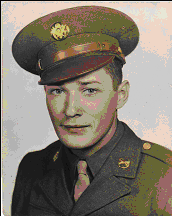
Cyril Duwayne Weddell was born to William and Mary (Plaatje) Weddell on August 9, 1924. He also had a sister named Ruby Weddell. The Weddells lived on a farm near Dante, South Dakota, and later moved southeast of Avon, South Dakota. Cyril attended rural schools and graduated from Avon High School on May 22, 1942. After graduation, Cyril moved to Deadwood, South Dakota. He worked for Montgomery Ward and Pioneer Fruit while in Deadwood.
His cousin, Mrs. Vivian (Weddell) Hubner remembered Cyril as being a helpful hand on the farm. She said, “He was a farm boy who grew up doing farm chores. As he got older, he would help the neighbors. He was a fun-loving boy.”
On March 31, 1945, Cyril D. Weddell of Headquarters Company Third Battalion, 291st Infantry was killed in action near Dorsten, Germany. He was laying wire while the Battalion was in attack. The jeep that he was driving ran over an enemy land mine. He is buried in the Netherlands American Cemetery in Margraten, Holland. He was laid to rest with full military honors.
Source: South Dakota WWII Memorial
Philip Pfaltzgraff is another of the business men of Dumont. He is a native of France, where he was born in 1852. His father, Frederick, emigrated to this country, from France, in 1854, and settled in Chicago. He came to Butler county in 1869, and settled on section 23, in Madison township, where he purchased a farm of Henry and N. Daniel. When the town of Dumont was started, Philip came to the new town and engaged in the hardware business. His wife was Anna, daughter of Henry Miller.
Source: History of Butler and Bremer Counties, Iowa ~ 1883
ABBOTT, George Bartlett. Physician and Surgeon. Res. 1928 1/2 Bonsallo ave.; office 712 Union Oil Bldg., Los Angeles. Born in Tyndall, S. D., Feb. 20, 1879; son of Thomas Henry and Julia (Ramsauer) Abbott. Married to Hester L. Beck (McDonald) in 1908. Educated in grammar schools at Tyndall, S. D. Early life spent in service of C. M. & St. P.; C., St. P., M. O. & U. P.; S. P., and Frisco systems, and Postal Telegraph Co. Entered Eclectic Medical College, San Francisco, in 1903; graduated in 1906; lost everything in fire of 1906; moved to Los Angeles 1909; Naturopathic Institute, Los Angeles, N.D., 1908; Palmer-Gregory Chiropractic College, D. C., Oklahoma City, Okla., 1911; licensed California State Board Medical Examiners, April 8, 1909. Secretary (State) Assn. Naturopathic Physicians of Cal.; secy. and treas. Naturopathic Publishing Co. Member Royal Arcanum ; Los Angeles Knickerbocker Club; Naturopathic Physicians of Cal.
Source: Who's Who in the Pacific Southwest ~ 1913
Robert Frank Billars was born in 1909 on a farm near Tyndall, to Frank and Antonette (Kocourek) Billars, the second oldest of four children. Other children were: William, Kaylor banker; Helen (deceased) former teacher and mother of Dr. John Stekly, Platte; and Louis, retired teacher, San Jose, Calif. In 1913 the Billars family moved to Kaylor, where all the children grew to maturity.
In 1928, Robert graduated from Scotland High School attended SDSU (1928-1931). He was fourth, fifth and sixth grade teacher in Kaylor Public Schools for four years, then obtained a B.A. Degree, and came back as principal of Kaylor Public Schools. He received his M.A. Degree from the University in 1942.
In 1937 Robert Billars and Lucille Groen of Parkston were married. Lucille received her degree from the University of Nebraska and was a teacher. The Billars moved to Ramona, where Bob was superintendent of schools for five years (1937-1942). Two children were born in Ramona, James Robert in 1938 and Janice Lucille in 1939.
During 1942-1944 Robert was superintendent at Jefferson, but he decided to go into another profession with more security.
In 1944, he began working for the Milwaukee Railroad and in September of that year the Billars family moved to Fairview, where Bob became station agent. A daughter, Karen Sue, was born in 1945. Shortly thereafter, the Stickney station was open. (K.L. Everett, who had served as agent for many years, moved to Delmont.) Bob was given the station position in May of 1946. His family moved to Stickney in June the same year.
Thomas Frank, the youngest of their children was born in 1946. Lucille began teaching, and for several years served as a rural teacher in the Wilson School, up to the time of her death in 1952. Bob and children continued to reside in the depot for the next seven and one-half years. He married Wilma Bryan Larsen in 1959. Wilma had served for many years as upper grade instructor in the Stickney Public Schools, and continued to do so for a total of 32 years until her retirement in 1976.
Bob stayed as agent of the Stickney-Corsica Stations to the time of their closing, July 1, 1967. He remained with the Milwaukee Railroad as agent at Lake Andes-Geddes until January 1968, the time of the stations' closing there. Bob's tenure with the Milwaukee lasted for nearly 24 years. The Stickney-Armour line continued in operation until September, 1972, with the necessary station work done by the agent at Tripp.
In 1968, Bob returned to teaching and became instructor and principal at Corsica serving for six years until his retirement in 1974. Bob and Wilma continue to live in Stickney. Bob has served on the Board of Education and as a member of The Fire Department. In 1959 he was selected as "Father of the Year" by the Mitchell newspaper.
All the Billars children are graduates of Stickney High School. James attended SDSU at Brookings before enlisting in the service. He was in the Air Force for four years, including a term in Taiwan. He received his B. S. Degree at SDSU in Electrical Engineering in 1965. Jim worked one year for General Electric on Shemya Island, in the Aleutian Islands. After receiving his M. A. Degree at Colorado State, he began work in 1968 for Marint-Marietta Corp. in electronic design. In 1971 he married Frances Davis VanScoy, a nurse. They have two children, Lianne Frances, born in 1973 and David James, born in 1979. Fran's two children, Sarah, 18 and Mike, 16, also live with them.
Janice Lucille was married to Harold Pecenka (Class of 1953, SHS) who is employed by the Argus Printers in Stickney. They have three children: Mary Beth, born in 1958 is a junior at USD, Vermillion; Michael Robert, born in 1960 is a sophomore at SDSU, Brookings; and Daniel Lee, born in 1962 is a junior in Stickney High School. Janice was Finance Officer for the Town of Stickney from 1969 to 1980, when she was appointed Clerk of Courts for Aurora County. She is organist at St. Mary's Catholic Church.
Karen Sue received a degree in nursing at SDSU in 1967, has a M.S. Degree from the University of Iowa, and a Ph.D. in Public Health from the University of Texas. She has taught at Universities in Florida, Georgia and Texas. She is active in the American Cancer Society. In 1971 she married Daryl Heusinkveld of Springfield, a graduate of the School of Mines at Rapid City, now a pilot for Delta Airlines in Houston, Texas. They have one son, Mark Robert, born in 1976.
Thomas is a graduate of DWU, Mitchell and has a degree in Optometry (1972) from Pacific University, Forest Grove, Ore. He practiced in Mitchell until September 1978. Tom and Marlene Sweetland of Mitchell were married in 1973. Marlene is a music instructor. They have two children, Lisa Marie, born in 1975 and Laurie Ann, born in 1978. In December of 1978 Tom joined the Optometric Clinic in Sioux Falls.
Source: Stickney (South Dakota) 75th Anniversary ~ 1980
William James was the oldest son of James Robinson. He studied for the ministry, graduating from Upper Iowa University. In his student days he roomed and boarded at the home of Professor Glasner. William James was married to Emma Glasner on the night of his graduation. Said our historian, "In that day ministers received very low salaries. Teachers were scarce and William James augmented his salary by teaching during the week, preaching on Sunday. At Chelsea, Iowa, he was superintendent of the school and his wife, Emma, was principal. Two of their four sons were born at Chelsea." Farming paid better than teaching or preaching, and a family had to eat. William James moved to a farm in northeast Iowa, and later to South Dakota.
Source: Silver Creek, Iowa Centennial History ~ 1952
Tabor’s 68th annual Czech Days celebration is being dedicated to the late Helen Vlasak during ceremonies on Friday, June 17, 2016 in Sokol Park at 3:00 p.m.
Helen Noll Vlasak was born on the homestead farm south of Tabor to Joseph J. and Sylvia (Ptak) Noll on June 18, 1916. She attended Tabor grade school, high school, and later attended business courses in night school while she worked in Omaha. She was employed as a housekeeper, a bookkeeper in the Tabor Bank, and was a group leader for Gurney Seed and Nursery Co. for fourteen seasons.
She married Clarence Vlasak on June 6, 1939 and raised three sons: Richard, Joseph (deceased) and David. She also has five grandchildren and ten great grandchildren.
Helen was a life member of the American Legion Auxiliary serving as president or chairman for forty years. Her elective offices were Unit, District, Department President and National Vice President of the Northwest Division. She was a National Committee Woman, an Area "D" National Rehabilitation Chairman, Area Communications Chairman, and Junior Activities Chairman, and also a life member of the Czech Heritage Preservation Society.
Helen wrote an essay for the "Make A Difference Day" and won a monetary award for the Legion Auxiliary. Those funds are being used for the display of the casket flags of our veterans at her request. Helen wrote many, many poems for almost any occasion. She wrote four pageants for Tabor, the largest of which was the Bi-Centennial Pageant with over two hundred people in the cast. She was a memorial speaker for Legion and Auxiliary memorials, as well as a memorial speaker for the Czech Days opening for the Czech Heritage Society. Her latest writings were that of humorous musical plays for the Czech Heritage Society in the Czech language.
Travel played a very important part of their lives as she traveled to twenty national conventions of the Legion Auxiliary. Clarence and Helen took many trips throughout the United States and many trips to Europe, Germany, Italy, Australia and most of them to the Czech Republic. Helen served as a counselor for Girls State of the American Legion Auxiliary. She also taught classes in the Czech language, both in school and as a part of the Czech Heritage Program. Her ambition was to see Tabor have a museum and that mission was accomplished.
Helen was a member of the St. Wenceslaus Catholic Church and a member of the church choir for over fifty years. She was the coordinator of the Polka Mass for many years and sang in the National Auxiliary chorus at two conventions. She took part in many plays, both in English and in the Czech language, both as a Sokol and for the Czech Heritage Preservation Society.
Helen passed away April 17, 2014.